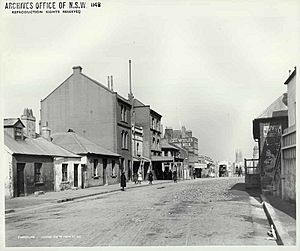Long's Lane Precinct facts for kids
Quick facts for kids 130 Cumberland Street, The Rocks |
|
|---|---|
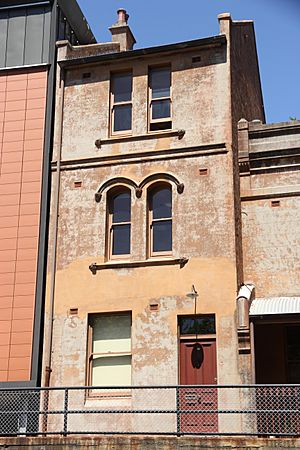
130 Cumberland Street, adjoining YHA Sydney on left, pictured in 2019.
|
|
| Location | 130 Cumberland Street, The Rocks, City of Sydney, New South Wales, Australia |
| Built | 1888–1888 |
| Architectural style(s) | Victorian Italianate |
| Owner | Property NSW |
| Official name: Terrace; Longs Lane Terraces/Precinct | |
| Type | State heritage (built) |
| Designated | 10 May 2002 |
| Reference no. | 1600 |
| Type | Terrace |
| Category | Residential buildings (private) |
| Lua error in Module:Location_map at line 420: attempt to index field 'wikibase' (a nil value). | |
| 132-134 Cumberland Street, The Rocks | |
|---|---|
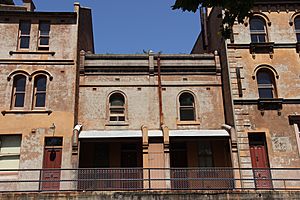
132-134 Cumberland Street; noticeably two storeys when the adjacent buildings are three storeys, pictured in 2019.
|
|
| Location | 132-134 Cumberland Street, The Rocks, City of Sydney, New South Wales, Australia |
| Built | 1891 |
| Architectural style(s) | Victorian Italianate |
| Owner | Property NSW |
| Official name: Terraces; Longs Lane Terraces/Precinct | |
| Type | State heritage (built) |
| Designated | 10 May 2002 |
| Reference no. | 1606 |
| Type | Terrace |
| Category | Residential buildings (private) |
| Lua error in Module:Location_map at line 420: attempt to index field 'wikibase' (a nil value). | |
| 136-138 Cumberland Street, The Rocks | |
|---|---|
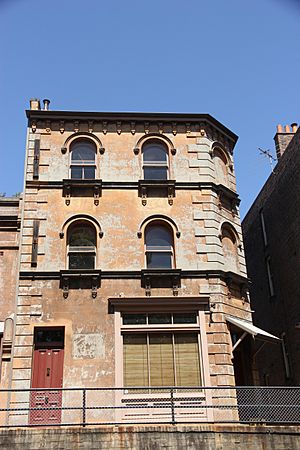
136-138 Cumberland Street, with Long's Lane at right, pictured in 2019.
|
|
| Location | 136-138 Cumberland Street, The Rocks, City of Sydney, New South Wales, Australia |
| Built | 1881–1882 |
| Architectural style(s) | Victorian Italianate |
| Owner | Property NSW |
| Official name: Shops and Residences; Longs Lane Terraces/Precinct; Watson's Butchery | |
| Type | State heritage (built) |
| Designated | 10 May 2002 |
| Reference no. | 1592 |
| Type | Terrace |
| Category | Residential buildings (private) |
| Lua error in Module:Location_map at line 420: attempt to index field 'wikibase' (a nil value). | |
| 140-142 Cumberland Street, The Rocks | |
|---|---|
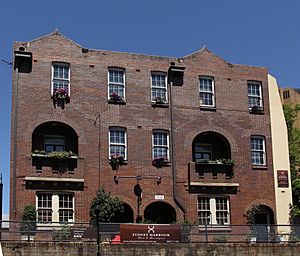
140-142 Cumberland Street, operating as Sydney Harbour Bed and Breakfast, pictured in 2019.
|
|
| Location | 140-142 Cumberland Street, The Rocks, City of Sydney, New South Wales, Australia |
| Built | 1914 |
| Architect | W. H. Foggitt |
| Architectural style(s) | Edwardian |
| Owner | Property NSW |
| Official name: Tenements, pair three-storey brick; Longs Lane Terraces/Precinct (Long's) | |
| Type | State heritage (built) |
| Designated | 10 May 2002 |
| Reference no. | 1599 |
| Type | Terrace |
| Category | Residential buildings (private) |
| Builders | NSW Government Housing Board |
| Lua error in Module:Location_map at line 420: attempt to index field 'wikibase' (a nil value). | |
The Long's Lane Precinct is a group of historic terrace houses in The Rocks, a famous area in Sydney, Australia. These buildings are located at 130, 132-134, 136-138, and 140-142 Cumberland Street. They were built between 1888 and 1914.
Terrace houses are a row of identical or similar houses joined by their side walls. These particular terraces are also known by names like Watson's Butchery. They are owned by Property NSW, a government agency. The entire precinct and the individual houses were added to the New South Wales State Heritage Register on 10 May 2002, meaning they are protected for their historical importance.
As of 2019, 140-142 Cumberland Street operates as the Sydney Harbour Bed and Breakfast.
Contents
What is the Long's Lane Precinct?
The Long's Lane Precinct is a special collection of old houses, backyards, and narrow laneways. It's located between Gloucester and Cumberland Streets in The Rocks. This area shows how people lived in Sydney from the mid-1800s to the early 1900s.
A Look Back in Time: History of the Terraces
The land where these houses stand has been used for a very long time. People started building homes here as early as the 1820s. Over the years, older buildings were replaced by new ones.
130 Cumberland Street
Around 1822, George Cribb built some houses here. These were later replaced by single-storey terraces in 1834. The current three-storey house was built in 1888. It was first rented by William McGee, a tobacconist.
In 1903, the NSW Government took over the land and building. This was part of a plan to improve The Rocks area. The house was lived in until 1976. For about ten years in the 1980s, the building was empty and damaged.
In the mid-1990s, the Sydney Cove Authority worked to fix up the buildings and laneways in the precinct. They tried to keep as much of the original building parts as possible. This restoration work won an award in 1998 for excellent urban design.
132-134 Cumberland Street
This site also had buildings on it very early, possibly around 1807. In 1822, George Cribb built houses here, which were replaced by single-storey terraces in 1834. The current two-storey houses were built in the early 1890s. They were made of brick and had iron roofs.
These houses stayed in the same family from 1833 until the government took them over in the early 1900s. Like 130 Cumberland Street, these buildings were also empty and damaged in the 1980s. The original inside layout of the houses is still mostly the same. The Sydney Cove Authority also restored these buildings in the 1990s.
136-138 Cumberland Street
This corner site also had early buildings, possibly from 1822. These were replaced by single-storey houses around 1834. The current three-storey building was constructed by 1882. It was designed to be a shop with living areas above. It had ten rooms and was made of brick with an iron roof.
John Johnson, who built the current building, sold it to Kellas Watson, a draper, in 1882. Watson might have run a drapery shop there. Later, it was used as a butcher shop and then a boarding house. The government took over this property in the early 1900s. It was rented out until the 1970s. Like the other buildings, it was boarded up and damaged in the 1980s before being restored in the 1990s.
140-142 Cumberland Street
This area was settled very early, even in the early 1800s. The land was officially granted to William Long in 1839. William Long was a former convict who became a successful wine merchant. He planned to build "ten handsome cottages" here. By 1845, there was a two-storey building on the corner, which was used as a house, shop, or even a pub called the "Erin-go-Bragh" (later "The Emerald").
A famous person, James Martin, who became Chief Justice and Premier of New South Wales three times, owned this property after marrying William Long's daughter.
Around 1900, after an outbreak of the Bubonic plague in Sydney, the NSW Government took over many areas, including The Rocks. From 1912, the NSW Housing Board began building new homes in The Rocks. This was the first government agency in NSW focused on building public housing.
The old buildings at 140-142 Cumberland Street were demolished by 1907. The current two-storey buildings were built in 1914 by J. H. Thompson, designed by architect W. Foggitt. These were part of a larger housing project for workers. They continued to be rented out until the 1970s. Like the other terraces, they were empty and damaged in the 1980s. Extensive restoration work was done between 1994 and 1995. Today, it is a bed and breakfast.
What Do They Look Like Today?
The Long's Lane Precinct buildings show different architectural styles from the late 1800s and early 1900s.
130 Cumberland Street
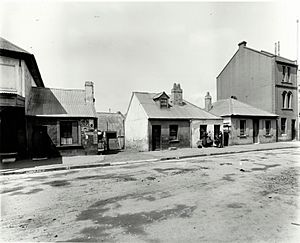
This is a three-storey building. It's built of brick covered in stucco (a type of plaster) and has an iron roof. It has decorative bands (moulded string courses) and rounded windows on the top two floors. It looks similar to other Italianate style terrace houses from the 1880s.
- Style: Late Victorian Italianate
- Storeys: Three
- Roof: Iron
- Changes: Renovated in the 1920s, and restored in 1992-1997.
132-134 Cumberland Street
These are two-storey terrace houses. They are also made of stuccoed brick with iron roofs. They have decorative bands and arched windows on the upper floor. They are a bit set back from the street compared to the buildings next to them, which allowed for a front porch.
- Style: Late Victorian Italianate
- Storeys: Two
- Facade: Rendered brick
- Roof: Iron
- Changes: Restored in 1992-1997.
136-138 Cumberland Street
This is a three-storey building on a corner. It's made of stuccoed brick with an iron roof. It has decorative bands, arched windows, and decorative corbels (support brackets). It was designed as a shop with living spaces above.
- Style: Late Victorian Italianate
- Storeys: Three
- Roof: Iron
- Changes: Restored in 1992-1997.
140-142 Cumberland Street
These buildings are part of a larger government housing project from the early 1900s. They show the Edwardian style.
- Style: Edwardian
- Storeys: Two
- Condition: Any digging on this site should be carefully watched by an archaeologist, as there might be old things buried there.
- Changes: Restored in 1992-1997.
Why Are They Important? Heritage Listing
The Long's Lane Precinct and its buildings are very important to the history of New South Wales. They are protected because they tell us a lot about how Sydney developed.
130 Cumberland Street: Why it's special
This house is important because it shows how people lived in inner-city Sydney in the late 1800s. It still has its original layout and many old features. Its location on a raised sandstone base makes it stand out. The careful restoration work in the 1990s also adds to its value, showing how heritage is preserved.
132-134 Cumberland Street: Why it's special
These houses are important because they are good examples of late 1800s residential terraces in The Rocks. They show how people lived and how the area grew. The way they are positioned on a raised sandstone base also makes them a local landmark. There's a good chance to find old things buried here from earlier times.
136-138 Cumberland Street: Why it's special
This building is important because it's a well-preserved example of a late 1800s commercial and residential building. It shows how shops and homes were combined in the city. Its design at the corner of Long's Lane and Cumberland Street is also very significant. Like the others, it has high archaeological potential.
140-142 Cumberland Street: Why it's special
This pair of buildings is very important because they are rare examples of early 1900s government-built worker's housing. They show how the NSW Housing Board, the first agency for public housing, helped people find homes. The buildings also show the Edwardian architectural style and how it was used for new types of housing. The site has potential for archaeological discoveries, helping us understand early life in The Rocks.
Images for kids
-
A sandstone laneway located within the precinct, leading towards the Big Dig Archaeological Site, pictured in 2019.


